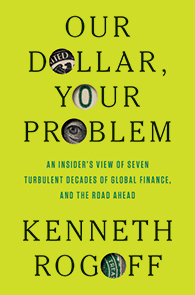The dollar remains central to the global economy despite the search for alternatives
Our Dollar, Your Problem: An Insider’s View of Seven Turbulent Decades of Global Finance, and the Road Ahead
Kenneth Rogoff
Yale University Press
New Haven, CT, 2025, 360 pp., $35
How has the US dollar dominated the global financial system for so long? Harvard economics professor Kenneth Rogoff seeks to answer this question in Our Dollar, Your Problem. As the world comes to terms with the dollar’s weaponization in geopolitical rivalries and recent flight from US financial assets, the book couldn’t be timelier.
Rogoff compares the dollar’s post–World War II performance with other major currencies. While the Soviet ruble was never a serious competitor to the dollar, the Japanese yen at one point was. However, the yen’s sharp appreciation after the 1985 Plaza Accord fueled a bubble in Japan’s stocks and real estate. By the time Japan had recovered from the bursting of the bubble, the US and its dollar had forged ahead.
The dollar seems equally likely to see off more recent rivals, Rogoff argues. The euro, the world’s second-leading reserve currency, is used mostly for trade between European nations. China, meanwhile, faces many obstacles in its bid to challenge dollar supremacy with the renminbi.
Rogoff is an experienced guide. He studied at the Massachusetts Institute of Technology in the late 1970s under Rüdiger Dornbusch, the pioneer of modern exchange rate models. He worked at the Federal Reserve’s international finance division in the early 1980s and at the IMF as chief economist in the early 2000s, and has taught in economics departments at some of the top US universities.
Most countries adapt to the dollar’s dominance and often peg their own currencies to it. Fixed exchange rates have contributed to all major crises in emerging markets, including in Mexico in 1994, East Asia in 1997, and Argentina in 2002. Rogoff calls for flexible exchange rates, paired with inflation targeting and independent central banks, policy advice he helped pioneer as early as 1995. Several emerging market economies have since made this triptych, along with the stockpiling of foreign reserves and strengthening their financial system, a cornerstone of their macroeconomic policies.
The dollar remains central to the global economy despite the search for alternatives and the recent rise of cryptocurrencies and central bank digital currencies (CBDCs). A digital dollar would easily eclipse other CBDCs because of the greenback’s status as the leading currency, combined with US technological leadership, the author argues. He is skeptical of cryptocurrencies’ ability to evade official control; governments have always found ways to regulate private currencies, he says.
The dollar’s supremacy, as Valéry Giscard d’Estaing, France’s then–finance minister, observed in the 1960s, bestows “exorbitant privilege.” By this he meant the US ability to sell government debt at lower interest rates and run large current account deficits for decades without threatening its international investment position.
But failure to fulfill the responsibilities that come with this privilege—such as providing dollars to the world economy during times of global stress—could ultimately undermine the dollar’s dominance. So too, Rogoff warns, could mounting US debt and an unfounded belief that lower interest rates will last forever, as could complacency about inflation and challenges to the Federal Reserve’s independence.
Our Dollar, Your Problem is a valuable guide for policymakers navigating current global financial challenges. It provides a nuanced examination of the geopolitical and economic implications of a dollar-centric world and makes a significant contribution to recent literature on dollar dominance.
Opinions expressed in articles and other materials are those of the authors; they do not necessarily reflect IMF policy.










